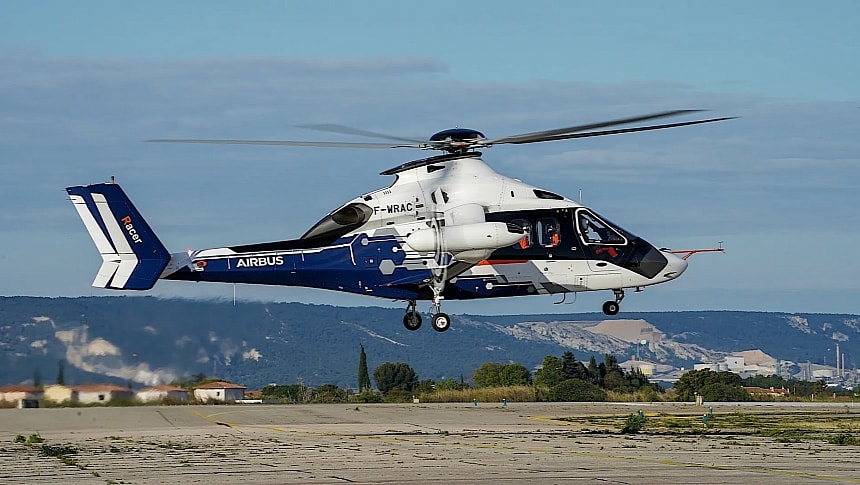The aviation industry is presently racing to find new and more fuel-efficient ways to keep aircraft flying. We see that most of all happening with fixed-wing aircraft, but helicopters are beginning to feel the pressure as well. And what you're about to read below is the spectacular way European aerospace giant Airbus decided to answer that pressure.
Back in 2017, during the Paris Air Show, Airbus showed the world the first glimpse of something called the Racer. The thing was introduced into the world as a high-speed experimental helicopter that could turn into a very versatile production one.
The helicopter is based on the Eurocopter X3 (X-Cubed) demonstrator, it too based in part on a Eurocopter Dauphin. It was perhaps the weirdest helo design of modern times, sporting the usual rotor up top but boasting two side ones attached to wings.
The X3 was designed in this configuration with a single goal in mind: it was used by Airbus to break the speed record for helicopters back in 2013, when it traveled at an insane 293 mph (472 kph).
The Racer is, as per Airbus, the intermediary aircraft that will take the X3 and eventually turn it from a prototype into something that can be used for real-world missions. The kind of missions that require capabilities only helicopters can offer, but also a speed much higher than what others are capable of.
The helicopter sets itself apart from the rest of the pack through a series of innovative features meant not only to give it speed, but also to cut down on fuel consumption.
Although it is capable of reaching speeds close to the record set by the X3, 249 mph (400 kph), the Racer should need 20 percent less fuel to work than helicopters of the same class. And that's all made possible by an innovative feature of the engine.
The Racer is powered by a pair of Safran Aneto-1X engines, a family of powerplants with power ratings in the 2,500 shaft horsepower class. Thanks to a hybrid-electrical eco-mode installed on the helo, one of these engines can be placed in stand-by mid-flight (in cruise stage).
It took Airbus quite a long time to develop the Racer, as it was only last week when the Europeans announced the maiden flight of the helo. It was a short run, lasting just 30 minutes, but more than enough for engineers to "check the overall behavior of the aircraft."
Now that it has proven that the helicopter can take to the sky, Airbus will begin a two-year-long campaign aimed to "progressively open the aircraft's flight envelope and demonstrate its high-speed capabilities."
When ready for production the Racer is seen as a potential tool for public services, emergency services, and even passenger transport.
The helicopter is based on the Eurocopter X3 (X-Cubed) demonstrator, it too based in part on a Eurocopter Dauphin. It was perhaps the weirdest helo design of modern times, sporting the usual rotor up top but boasting two side ones attached to wings.
The X3 was designed in this configuration with a single goal in mind: it was used by Airbus to break the speed record for helicopters back in 2013, when it traveled at an insane 293 mph (472 kph).
The Racer is, as per Airbus, the intermediary aircraft that will take the X3 and eventually turn it from a prototype into something that can be used for real-world missions. The kind of missions that require capabilities only helicopters can offer, but also a speed much higher than what others are capable of.
The helicopter sets itself apart from the rest of the pack through a series of innovative features meant not only to give it speed, but also to cut down on fuel consumption.
Although it is capable of reaching speeds close to the record set by the X3, 249 mph (400 kph), the Racer should need 20 percent less fuel to work than helicopters of the same class. And that's all made possible by an innovative feature of the engine.
The Racer is powered by a pair of Safran Aneto-1X engines, a family of powerplants with power ratings in the 2,500 shaft horsepower class. Thanks to a hybrid-electrical eco-mode installed on the helo, one of these engines can be placed in stand-by mid-flight (in cruise stage).
It took Airbus quite a long time to develop the Racer, as it was only last week when the Europeans announced the maiden flight of the helo. It was a short run, lasting just 30 minutes, but more than enough for engineers to "check the overall behavior of the aircraft."
Now that it has proven that the helicopter can take to the sky, Airbus will begin a two-year-long campaign aimed to "progressively open the aircraft's flight envelope and demonstrate its high-speed capabilities."
When ready for production the Racer is seen as a potential tool for public services, emergency services, and even passenger transport.






